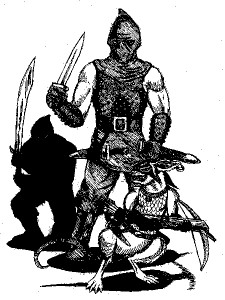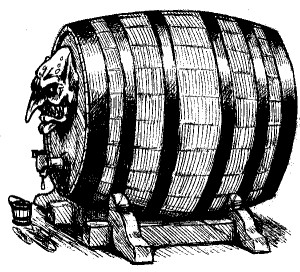They are both majestic and terrifyingly powerful beasts that dominate both the air and the land with their fearsome talons and vicious teeth. They wield the power of fire or poison and scales like shields. These great lizards have been used as symbols for heavenly or hellish might as well as to adorn the shields and banners of knights and kings. In fable and the popular mind they exhibit the penchant for kidnapping (and a peculiar appetite for) young maidens and stand as the ultimate examples of overwhelming greed when portrayed sleeping on hill-tall piles of treasure, their hoards of gold. Dragons are a staple, and occasionally the focus of, tabletop roleplaying games and, as several other ‘classic’ RP monsters they have been drawn not only from popular fiction but up from the deepest mists of time and mythology.
“Described and feared by human cultures worldwide from the earliest times, the dragon exists in a vast range of forms and abodes in myth and legend.” [McGovern, Una, ed. 2007. Chambers Dictionary of the Unexplained. Chambers Harrap Publishers Ltd. Dragons]
Classically dragons are split into two primary classifications especially when it comes to mythological comparisons though the primary features of the RPG dragon are found mostly with one, the dragon of European lore but the contemporary idea of which seems to move ever closer to the mannerisms of the other, the Eastern Dragon, in both role-playing games and fiction. There is a stark contrast between these two classic types so much so that they appear to be near mirror opposites. These two classifications are defined as The Eastern Dragon and the Western Dragon.
Western dragons are the classic evil monster and have an appearance familiar to anyone who has had even a glancing association with popular fantasy fiction and/or role-playing games. They have bat-like wings, four limbs that end in nasty claws, crocodilian jaws studded with ripping teeth, a tail like a bullwhip, horns on the head (perhaps owed to their Christian religious symbology), and occasionally a barb at the end of the tail.
“The classical Western dragon is a malevolent fire-breathing monster encased in an armour of shimmering scales, borne upon four powerful limbs with talon-equipped feet, and sporting a pair of huge leathery wings, plus a long tail tipped with a poisonous barb or arrow-headed sting.” [McGovern. Dragon]
The European tail-barb however seems to be a recent, comparatively speaking, addition acquired by some dragons from the heraldic likeness, more reserved these days for dragon-like monsters such as Wyverns.
“In nearly all modern representations the tail, like the tongue, will be found ending in a barb, but it should be observed that this is a comparatively recent addition. All dragons of the Tudor period were invariably represented without any such additions to their tails.” [Fox-Davies. 1978. A Complete Guide to Heraldry. Bonanza Books, New York. 225]
One of the most ancient stories involving dragons and the one that best demonstrates the shear ‘epicness’ of the creatures is the Mesopotamian creation myth wherein Marduk, the chief god of Babylon, hunts down and slays the she-dragon Tiamat.
“Marduk searched the universe for Tiamat, his dragon mother. […] He spread his net across the void and caught her in it [.] Then, taking aim with his bow, Marduk shot an arrow between Tiamat’s open jaws, straight down into her heart. Then he disposed of Tiamat’s […] monstrous carcass. He split her skull and severed her arteries; he cleft her body “like a fish into its two parts,” from one of which he fashioned the firmament and from the other the solid earth.” [Constable, George, ed. 1984. The Enchanted World: Dragons. Time-Life Books. Alexandria, Virginia. 14, 18]
From the very beginning dragons and the power contained in their awesome forms shaped, and in this case formed, the natural world.
“Having positioned the celestial bodies, Marduk used Tiamat’s spit for clouds, placed a mountain on her head, and made an outlet from her eyes for the waters of the Euphrates and the Tigris.” [van der Toorn, Karel. 1999. Dictionary of Deities and Demons in the Bible, Second Edition. Brill Academic Publishers, The Netherlands. Tiamat]
The dragon goddess stood as an embodiment of a single massive natural force, all the salt-water of the earth. “Tiamat is the personified primeval ocean [.]” [van der Toorn. Tiamat] In the Old Testament a term translated as “the deep” and that is etymologically related to Tiamat is frequently used not only as a designation of the primeval sea but also to denote the cosmic sea (Yam) on which the world floats, “and from which all water comes, as well as any large body of water, including rivers, and the depth of the sea and the earth.” [van der Toorn. Tiamat]
In Medieval Europe and England the dragon was a symbol of Satan and thus inherently evil and wielded a significant amount of supernatural power requiring a righteous (and blessed) hero to eliminate the beast.
“In western myth battles with dragons symbolize the struggle between good and evil or the mastering of man’s base nature and reflect early Christian beliefs. Rescuing a maiden from a dragon represents the release of pure forces after vanquishing evil. Treasure-guarding dragons often signify the struggle to attain coveted inner knowledge.” [Wilkinson, Kathryn, ed. 2008. Signs & Symbols: An Illustrated Guide to their Origins and Meanings. DK Publishing. Dragons]
Perhaps the best known examples of the medieval Western dragon popular today are the story of St. George and the dragon and that of Sigurd the dragon-slayer and Fafnir (the dwarf/dragon) in the Icelandic Volsunga Saga popularized by Richard Wagner in his 1876 Der Ring des Nibelungen (Wagner’s Ring Cycle). The dragon may have been acquired as a symbol of the devil by medieval Europeans due to the portrayal of the creatures in the bible; namely in the New Testament in Revelations, the Apocrypha, and in the Greek texts of the Pseudepigrapha.
“The dragon has often a fiery appearance, behaves in an aggressive, insolent and lecherous way and often represents the powers of chaos, especially in primordial times. The dragon is sometimes connected with natural phenomena like storm, flood or drought.” [van der Toorn. Dragon]
They are also, sometimes still, associated with serpents which are in turn related in symbolic terms if not also in appearance to the serpent in the Garden of Eden which tempted Eve with the apple.
“A dragon is a fabulous winged crocodile, usually represented as of large size, with a serpent’s tail, so that dragon and SERPENT are sometimes interchangeable.” [Rockwood, Camilla, ed. 2009. Brewer’s Dictionary of Phrase & Fable, 18th Edition. Chambers Harrap Publishers Ltd. Dragon]
This of course, continuing in the biblical vein, leads us to dragons as the ultimate symbol of evil as the serpent of the garden is taken popularly to be Satan in one of his favorite guises.
“In most Mediterranean and European MYTHOLOGIES, SERPENTS are associated with evil, and dragons, a sort of super-serpent, are more evil still.” [Clute, John & Grant, John. 1997. The Encyclopedia of Fantasy. St Martin’s Press, New York. Dragons]
The concept of the dragon was originally inseparable from that of serpents and was in fact synonymous for ages. This association and synonymy with serpents began with the etymology of the word ‘dragon’ itself.
“The Greek word drakēn is related to drakos, ‘eye’, and in classical legend the idea of watching is retained in the story of the dragon who guards the golden apples in the Garden of the HESPERIDES, and in the story of CADMUS.” [Rockwood. Dragon]
Later the romans appropriated the Greek word giving it a more recognizable form.
“In Latin, the Greek word was converted to draco, and it came to mean “giant snake.” To the Romans the dragon was a giant snake, probably a python from India or Africa.” [Cohen, Daniel. 1982. The Encyclopedia of Monsters. Dorset Press, New York. 228]
This serpent-dragon concept continued well into the middle ages especially in England.
“Most British dragons… are of the worm variety – lacking wings and legs, with lengthy, elongate bodies, and emitting poisonous vapours rather than fire.” [McGovern, Una, ed. 2007. Chambers Dictionary of the Unexplained. Chambers Harrap Publishers Ltd. Dragon]
In time the image of the dragon with its association with elemental and physical might was integrated into the heraldic arms of certain individuals and families.
“Among the ancient Britons and the Welsh the dragon was the national symbol on the war standard. Hence the term PENDRAGON for the dux bellorum, or leader in war.” [Rockwood. Dragon]
It seems not until they were adopted as heraldic monsters gracing the banners of noble families and warlords did they begin to take on their more recognizable form.
“The head of a dragon is like nothing else in heraldry, and from what source it originated or what basis existed for ancient heraldic artists to imagine it from must remain a mystery, … It is like nothing else in heaven or on earth. [T]he wings of the dragon are always represented as the wings of a bat[.]” [Fox-Davies. 1978. A Complete Guide to Heraldry. Bonanza Books, New York. 224]
By the end of the middle ages the Western Dragon had attained its classic appearance, monstrous attitude, and symbolic meaning. It was a powerful beast with breath of fire and an evil disposition which only champions of good could quell. Eastern dragons however were primordial beasts which were often beneficial to humankind.
“Oriental dragons are very different from the dragons of the West. Oriental mythology includes many kinds of dragons, and collectively they influence and control every aspect of nature and the affairs of mankind. In stark contrast to their Western counterparts, Oriental dragons are exceedingly wise, are capable of flying without the aid of wings and (aside from spasmodic outbursts of anger) they appear relatively benevolent in their interactions with humanity. They are also revered – to the extent that many of the East’s most ancient and august human lineages claim direct descent from a dragon.” [McGovern. Dragon]
The Eastern Dragon appears as a scaled serpentine creature with the branching horns of a stag and eagle-talons on their four feet. They often have ‘feelers’ on either side of their toothy maw identical to those of a catfish, are portrayed as aquatic, and/or soaring playfully through the clouds with the ability to fly through the air without the aid of wings.
“In China dragons were Associated with the weather and were thought to be rain-bringers; some of the country’s worst floods were attributed to humans upsetting a dragon. Chinese dragons were believed to control water, vital for crops. In contrast, western dragons control fire.” [Wilkinson. 36]
In the East, dragons were powerful elemental beings to be revered and feared when offended. They wielded a significant amount of mystical ability and not just the ability to swim through the air as they did through water but the ability to exert a divine level of control over the weather and over the water in which they lived.
“Dragons were held to exercise control over rainfall, and are often depicted playing with a ball or pearl (symbol of thunder) among the rainclouds.” [Whittaker, Clio. 2007. An Introduction to Oriental Mythology. Quantum Publishing Ltd., London. 38]
Basically, Eastern Dragons brought immense elemental power with them being not just a powerful supernatural force in the world; they were of the world, a part of the very natural world that their existence would seem to defy. They combined certain mystical aspects of nature.
“[T]he dragon began as a benign symbol representing the fertilizing waters of the serpent and the divine “breath of life” of the bird; the latter also associated with it sky deities and rulers. Later the dragon became symbolically ambivalent, and was seen as both creative and destructive.” [Wilkinson. Dragons]
They also gained the power of symbolism absorbing and incorporating certain human aspects.
“They are symbols of great power, spiritual and temporal, and are associated with wisdom, strength, and the creative forces of nature. They are revered and temples are dedicated to them.” [Wilkinson. Dragons]
Seemingly as the Western Dragon carried the sheer physical menace and viciousness now associated with the RPG Dragon, the Eastern Dragon seems to have brought the mystical and elemental abilities as well as the superior spiritual attributes found to a lesser extent in humanity. Of course, the current trends in both pop-literature and roleplaying games have begun forging the two together along with heaps of personality.
“The dragons of Chinese mythology, by contrast [to those of the Western sort], are usually benevolent. This tradition has facilitated REVISIONIST FANTASY about dragons of the Western sort.” [Clute & Grant. Dragons]
The RPG dragon draws from both mythological types as well as from popular fiction all hung on the skeleton of the war-gaming dragon. Dragons as did wizards, started as simple field pieces of surprising power on the fields of fantasy battles waged in the early heyday of miniature war-gaming. These dragons pretty much took solely from the Western type dragon requiring only the physical might and fire breath (not to mention the advantage of flight) on the field. They evolved as did the first major role-playing game, Dungeons & Dragons, from the war game but were also injected with some new DNA found in certain works of fantasy fiction.
These works are listed in Appendix N from the 1977 edition of the Advanced Dungeons & Dragons Dungeon Masters Guide by Gary Gygax where he cites them as primary inspirations for the game. Of primary interest are the Elric books by Michael Moorcock and of course, the Hobbit by J.R.R. Tolkien. Both of these series of books having much to do with the current form of RPG Dragons. When it comes to Moorcock’s tales of Elric, the morose albino black-rune-sword wielding dragon-riding prince, it is within the Dreaming City (not specifically cited in Appendix N but it was published originally in 1961, well within time to inspire Gary Gygax) that the form of the current era RPG dragon takes shape.
“They were dragons, without doubt! The great reptiles were some miles away, but Elric knew the stamp of the huge flying beasts. The average wing-span of these near-extinct monsters was some thirty feet across. Their snake-like bodies, beginning in a narrow snouted head and terminating in a dreadful whip of a tail were forty feet long and although they did not breathe the legendary fire and smoke, Elric knew that their venom was combustible and could set fire to wood or Fabric on contact.” [Moorcock, Michael. The Elric Saga, Part I. Nelson Doubleday Inc. Garden City, New York. 305]
To that framework built of the war-game field piece and fleshed out with the physical-ness of Elric’s dragons the next influence to add to the RPG Dragon, an element which would train the sights of greedy adventurers forevermore in their direction, is the work of Tolkien.
In particular the Hobbit, the work of his cited in Appendix N and so a direct relation, and the dragon Smaug which is present within. Smaug, a flying fire-breathing beast, seizes the dwarven kingdom of Erebor under the Lonely Mountain for himself and covets the unbelievable mass of treasure within as his hoard atop which he slumbers.
“There he lay, a vast red-golden dragon, fast asleep; a thrumming came from his jaws and nostrils, and wisps of smoke, but his fires were low in slumber. Beneath him, under all his limbs and his huge coiled tail, and about him on all sides stretching away across unseen floors, lay countless piles of precious things, gold wrought and unwrought, gems and jewels, and silver red-stained in the ruddy light.” [Tolkien, J.R.R. 1997. The Hobbit. Houghton Mifflin Company, Boston. 184]
Of course, Tolkien modeled Smaug after the traditional European mythic dragon in particular Fafnir; Smaug is greedy, covetous, and pure malignant evil, a perfect example of the classic Western Dragon. Tolkien’s Inklings compatriot C.S. Lewis attributed the same quality to his version of the monster equating it more however as a symbol of greed, one of the seven deadly sins.
“Dragons are emblems of covetousness – when, in The Voyage of the Dawn Treader (1952) C.S. Lewis’s Eustace is turned into one, it is by thinking covetous thoughts about the horde he has come across. Wagner’s Fafner has similarly opted to change into a dragon in order to better guard the CURSE-ridden hoard for which he has already sacrificed his brother. Though dragons like Tolkien’s Smaug are typologically related to the Satanic dragon of Christianity, their hoard derives from the Norse version of dragonishness. This is at once one of their defining characteristics and their Achilles’ Heel; it is because he has suffered a theft from his hoard that Smaug emerges, and is thus killed.” [Clute & Grant. Dragons]
This hoarding trait is definitely present in RP Dragons if not one of their primary distinguishing traits.
Other works attached details to the RPG Dragon and explained details and behaviors of dragons in order to increase believability and foster reader immersion. These works used, and some continue to use, techniques known as Rationalized Fantasy, that is “stock fantasy elements are given a rationale that provides them with internal consistency and coherence.” [Clute & Grant. Rationalized Fantasy.] These works add in taxonomies, species, detailed or not so detailed explanations of draconic physiology and anatomy as well behavior even psychology. These works includes the likes of the Dragonriders of Pern by Anne McCaffrey, The Flight of Dragons by Peter Dickinson, the Dragon Jousters series by Mercedes Lackey, and the more recent Temeraire series of books authored by Naomi Novik.
These types of fantasy novels add in multiple details fitting dragons into the natural world making them powerful, majestic, but still fearsome beasts that may be preternatural but very much animals with a niche all their own – they like the rest of the animal kingdom including the whole of humankind are biological entities with a definite anatomy. Peter Dickinson’s work, The Flight of Dragons, is a testament to the rationalization of fantastic beasts laying out a blue-print for how the various aspects of the mythical creature could fit into the mundane world.
“[M]y theory is that the particular specialisation of dragons was that they evolved a unique mode of flight. They grew to their enourmous size because size was necessary if they were to fly successfully. They breathed fire because they had to. Their “blood” had seemingly magical properties because a particular chemical reaction was necessary for their mode of flight. And so on. At the remoter fringes of the theory I think I can show how the life-form that evolved through this specialisation came to prefer for its diet young ladies of noble breeding.” [Dickinson, Peter. 1979. The Flight of Dragons. Perrot Publishing Limited. 16]
However, the foremost of these works would be Anne McCaffrey’s the Dragonriders of Pern where the dragons were differentiated from each other by the colors of their scales to which size was also attached (Gold, Bronze, Brown, Blue, Green, with gold being the largest and green the smallest); a sort of color-coding as it were. The Pern series of books are more sci-fi than fantasy and the Pernese dragons are described as genetically modified versions of Pern’s native fire-lizards only resembling the mythical dragon in that they resemble fire-breathing winged dinosaurs, in fact dubbed “dragons” due to that resemblance by the planetary colonists that bred them.
When it comes to mating the Pern series of novels are very descriptive mostly from an emotional angle. The Pernese dragons share a telepathic link with their riders and influence the sexuality of their riders and others around them particularly evident during the described mating ritual. The sexuality of the Pernese dragons does have a definite relationship with the sexuality of their riders and to whom they will “impress” due to their intense tele-empathic bond, later clarified by the author herself [McCaffrey, Anne. 2000. Pern’s Renewable Airforce]. This talk of dragon-sex brings us to a strange behavior attributed to dragons in the popular imagination and myth, the awkward habit of kidnapping maidens.
“Dragons’ legendary habit of devouring maidens is something many fantasists have tried to rationalize. Because dragons are seen as solitary, they have to have some sort of sexuality, and eating virgins fits the bill.” [Clute & Grant. Dragons]
This component of the draconic personality is often ignored or simply left out by most contemporary fiction and role-playing games. It was added by medieval literature.
“In medieval romance captive ladies were often guarded by dragons.” [Rockwood. Dragon]
An element of this strange trans-species draconic sexuality can be found in the Eastern Dragon as well.
“Dragons represent the male yang element.” [Whittaker. 38]
The philosophy behind Ying and Yang is that apparently contrary, not necessarily opposing, forces have an element of each other within themselves because they are interconnected. Ying and yang are an indivisible whole with Yin being the passive and/or feminine element and Yang, the dominant/male element.
In most of the fiction mentioned previously, dragons are used as either massively powerful weapons or, especially in Smaug’s case, the primary threat of the story which must be overcome. In all of these cases dragons are just essentially plot devices for the most part, the dragons in Temeraire are much more integrated as characters, however as Fiction Narrative and RPG Narratives are completely different dragons are primarily used in RPG’s as campaign-enders or set-pieces as the great threat marking a sort of chapter or book-end in a tabletop campaign.
They are ideal foils for Player Characters, great lumbering powerful beasts with fiery breath and a penchant for constructing or at least occupying complex often maze-like lairs which probably evolved in game-play starting as simple cave-lairs and quickly becoming something more complex as gameplay demanded. The penetration into the depths of a dragon’s lair can be a campaign in and of itself.
“As often as not, whether intelligent or bestial, dragons are the hunter, not the hunted. Standing as they do as a gate between life and death and as flesh-and-blood beings that are nonetheless magical in their essence, they are LIMINAL BEINGS often connected with the getting of wisdom rather than merely enemies to be confronted. A conversation with a dragon is always a kind of duel, a struggle to refuse hypnotism or mastery.” [Clute & Grant. Dragons]
RPG Dragons typically are not just a random encounter.
The dragon has evolved from a term essentially describing only a sharp-eyed serpent to a majestic beast representing primordial supernatural power. This traditional malleability of the dragon continues especially in the fantasy today not just as a symbol but as a literalized creature with certain authors building their own details not just to increase reader interest but also believability onto the mythical framework, the most influential in the realm of roleplaying being Michael Moorcock, Ann McCaffrey, and, of course, Tolkien. The mythical dragon is the root of certain RPG tropes when it comes to dragons: dragon-slayers (Marduk), half-dragons (the Chinese dragon).
The malleability of myth and the additions of fantasy authors have inspired the dragon-rider and the draconic character in roleplaying as well. The idea of dragons not only in RPG’s but in mythology itself seems to change to suit the role the creatures are set to play but have always represented an epic and earth-shattering experience wielding massive amounts of primordial magical power. “Mythology reveals the dragon as both creator and destroyer and involves epic themes such as cosmic chaos, creation, and rebirth.” [Wilkinson. Dragons] Dragons have evolved from the idea of gigantic serpents into a vast array of fantastical animals with their own biology and anatomies as varied and numerous as water on the face of the earth.
“There is a particular affinity between dragons and water in all its natural forms: seas, rivers, lakes, rain.” [Whittaker. 38]
The first RPG dragons were derived from fiction which borrowed from myth and took their form from war-games. Dragons in RPG’s have a deep and long lineage and thus can be very useful to the creative and clever Game-Master. Dragons can be built and designed by the GM using the transformative fictive elements found in popular fantasy fiction, and many already have been.
The GM should think of specific links to their setting such as special adaptations that would bind the native dragons inextricably to that setting. Creating believable dragons helps to not only surprise the players but grounds them within the campaign world providing a deeper level of immersion; the same result desired by the fiction authors via the same method. Coloration, scale patterns, the presence of hair, and any number of odd physical features or bizarre powers are all options. Dragons continue to evolve in the human mind shaped by the immense creative forces contained therein and so will continue to evolve and change with not only literature but also with fantasy roleplaying games in general.
[do_widget id=”cool_tag_cloud-4″ title=false]
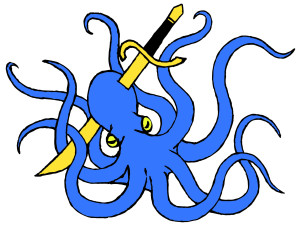 Xuun, dirty, and not only foul from the slimy heat of the swamp but Nezor had spent about a day wading in the murk searching for the sunken chests in the muddy bottom. He had recovered both the smaller oak chest and the other chest the contents of which Zevor supposedly had already divided amongst the robbers. The mithral chest was lost.
Xuun, dirty, and not only foul from the slimy heat of the swamp but Nezor had spent about a day wading in the murk searching for the sunken chests in the muddy bottom. He had recovered both the smaller oak chest and the other chest the contents of which Zevor supposedly had already divided amongst the robbers. The mithral chest was lost.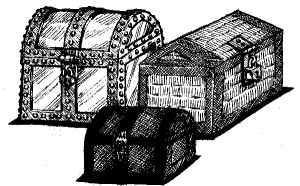 more worse for the wear. At the head of the line was Zevor with the hill-giant Nezor on his heels, a large chest tucked under each arm. The reassuring and strong scent of heavily spiced stew met the raw nostrils of the exhausted adventurers. The 3 rogues Zevor had brought along were hefting a third chest, an oak chest, smaller than the previous two but still substantial, on a creaking pole-carriage followed by the mage. Pulling up the rear were the deathgrin Cantra and the grim-warrior Phenox.
more worse for the wear. At the head of the line was Zevor with the hill-giant Nezor on his heels, a large chest tucked under each arm. The reassuring and strong scent of heavily spiced stew met the raw nostrils of the exhausted adventurers. The 3 rogues Zevor had brought along were hefting a third chest, an oak chest, smaller than the previous two but still substantial, on a creaking pole-carriage followed by the mage. Pulling up the rear were the deathgrin Cantra and the grim-warrior Phenox.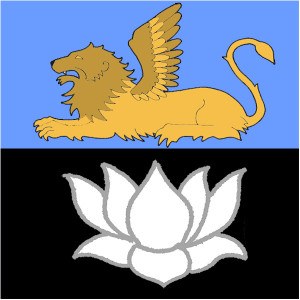 3 days had passed since the trio of “goodfellows” had traversed Xuun’s bazaar and outfitted with their new gear the trio finds themselves in the swamp astride a crude log raft piloted by one Gator-Tooth a swamper leatherback with tattoos over his bald sun-baked pate in a crocodile skin vest and canvas pantaloons. At its head serving his role as fearless leader, Zevor the Westlander rogue, and filling out the rest of the motley crew3 more rogues dressed similarly in studded black leathers and a Westlander mage dressed in a brown robe with gold trim serving as mercenary.
3 days had passed since the trio of “goodfellows” had traversed Xuun’s bazaar and outfitted with their new gear the trio finds themselves in the swamp astride a crude log raft piloted by one Gator-Tooth a swamper leatherback with tattoos over his bald sun-baked pate in a crocodile skin vest and canvas pantaloons. At its head serving his role as fearless leader, Zevor the Westlander rogue, and filling out the rest of the motley crew3 more rogues dressed similarly in studded black leathers and a Westlander mage dressed in a brown robe with gold trim serving as mercenary.